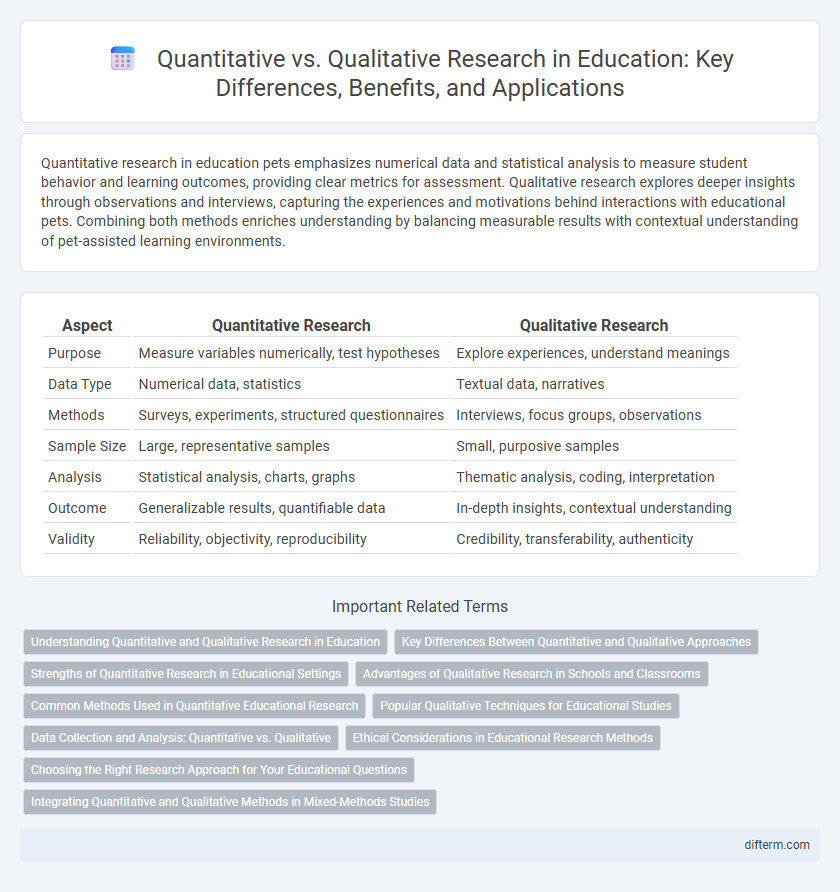Quantitative research in education pets emphasizes numerical data and statistical analysis to measure student behavior and learning outcomes, providing clear metrics for assessment. Qualitative research explores deeper insights through observations and interviews, capturing the experiences and motivations behind interactions with educational pets. Combining both methods enriches understanding by balancing measurable results with contextual understanding of pet-assisted learning environments.
Table of Comparison
| Aspect | Quantitative Research | Qualitative Research |
|---|---|---|
| Purpose | Measure variables numerically, test hypotheses | Explore experiences, understand meanings |
| Data Type | Numerical data, statistics | Textual data, narratives |
| Methods | Surveys, experiments, structured questionnaires | Interviews, focus groups, observations |
| Sample Size | Large, representative samples | Small, purposive samples |
| Analysis | Statistical analysis, charts, graphs | Thematic analysis, coding, interpretation |
| Outcome | Generalizable results, quantifiable data | In-depth insights, contextual understanding |
| Validity | Reliability, objectivity, reproducibility | Credibility, transferability, authenticity |
Understanding Quantitative and Qualitative Research in Education
Quantitative research in education involves collecting numerical data through surveys, assessments, and experiments to identify patterns and measure variables objectively. Qualitative research focuses on exploring students' experiences, behaviors, and attitudes using interviews, observations, and case studies to gain in-depth insights. Combining both approaches enhances comprehensive understanding of educational processes and outcomes, informing evidence-based policy and practice.
Key Differences Between Quantitative and Qualitative Approaches
Quantitative research in education emphasizes numerical data, statistical analysis, and objective measurements to identify patterns and test hypotheses, often using surveys and experiments. Qualitative research focuses on understanding educational experiences, behaviors, and social contexts through subjective methods like interviews, observations, and thematic analysis. Key differences include the nature of data, with quantitative research providing quantifiable evidence and qualitative research offering in-depth insights into complex educational phenomena.
Strengths of Quantitative Research in Educational Settings
Quantitative research in educational settings excels in its ability to provide measurable and statistically significant data, allowing educators to identify trends and make data-driven decisions. Its structured approach facilitates large-scale studies that enhance generalizability and reliability across diverse student populations. Quantitative methods also support the evaluation of educational interventions by offering clear metrics to assess effectiveness and inform policy development.
Advantages of Qualitative Research in Schools and Classrooms
Qualitative research in schools enables educators to gain in-depth insights into students' experiences, motivations, and social interactions, fostering a holistic understanding of classroom dynamics. This approach captures nuanced data through interviews, observations, and open-ended responses, which quantitative methods often overlook. By emphasizing context and meaning, qualitative research supports personalized teaching strategies and promotes inclusive educational practices.
Common Methods Used in Quantitative Educational Research
Common methods used in quantitative educational research include surveys, standardized assessments, and experimental designs that collect numerical data to identify patterns and relationships. Statistical techniques such as regression analysis, ANOVA, and descriptive statistics are employed to analyze data and test hypotheses. These methods enable researchers to quantify variables and measure educational outcomes with precision and reliability.
Popular Qualitative Techniques for Educational Studies
Popular qualitative techniques for educational studies include interviews, focus groups, and classroom observations, which provide rich, contextual insights into student experiences and teaching practices. These methods allow researchers to explore complex phenomena such as motivation, engagement, and learning processes through detailed, narrative data. Unlike quantitative research, qualitative approaches prioritize depth over generalizability, making them essential for understanding the nuanced dynamics within educational settings.
Data Collection and Analysis: Quantitative vs. Qualitative
Quantitative research relies on structured tools such as surveys and questionnaires to collect numerical data, enabling statistical analysis that identifies patterns and tests hypotheses. Qualitative research gathers non-numerical data through interviews, focus groups, and observations, emphasizing thematic analysis to explore complex behaviors and meanings. The contrasting data collection methods directly influence the analytical approach, with quantitative focusing on measurable variables and qualitative prioritizing context-rich, interpretative insights.
Ethical Considerations in Educational Research Methods
Quantitative research in education demands strict adherence to informed consent, data confidentiality, and protection of participant anonymity to uphold ethical standards. Qualitative research requires researchers to navigate complex issues related to researcher bias, participant vulnerability, and the ethical interpretation of subjective data. Ensuring transparency and maintaining the trust of students, teachers, and educational communities remain central ethical concerns across both methodologies.
Choosing the Right Research Approach for Your Educational Questions
Quantitative research employs structured methods such as surveys and experiments to collect numerical data, ideal for measuring trends and testing hypotheses in education. Qualitative research utilizes interviews, observations, and thematic analysis to explore complex educational phenomena and understand participants' perspectives deeply. Selecting the appropriate approach depends on your research questions: use quantitative methods for measurable outcomes and qualitative methods for exploring experiences and meanings in educational settings.
Integrating Quantitative and Qualitative Methods in Mixed-Methods Studies
Integrating quantitative and qualitative methods in mixed-methods studies enhances the depth and breadth of educational research by capturing both statistical trends and rich contextual insights. Quantitative data provides measurable evidence through surveys and experiments, while qualitative techniques such as interviews and observations offer nuanced understanding of learner experiences. This methodological convergence supports more comprehensive analysis, fostering informed decision-making in curriculum development and educational policy.
quantitative research vs qualitative research Infographic

 difterm.com
difterm.com